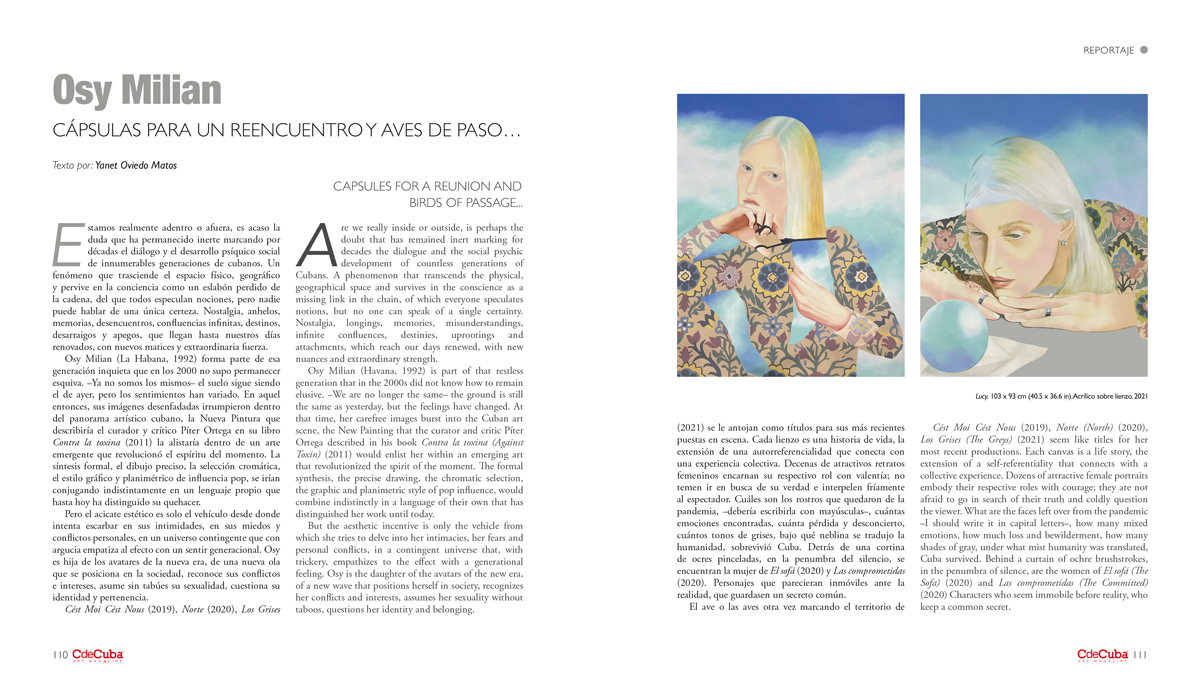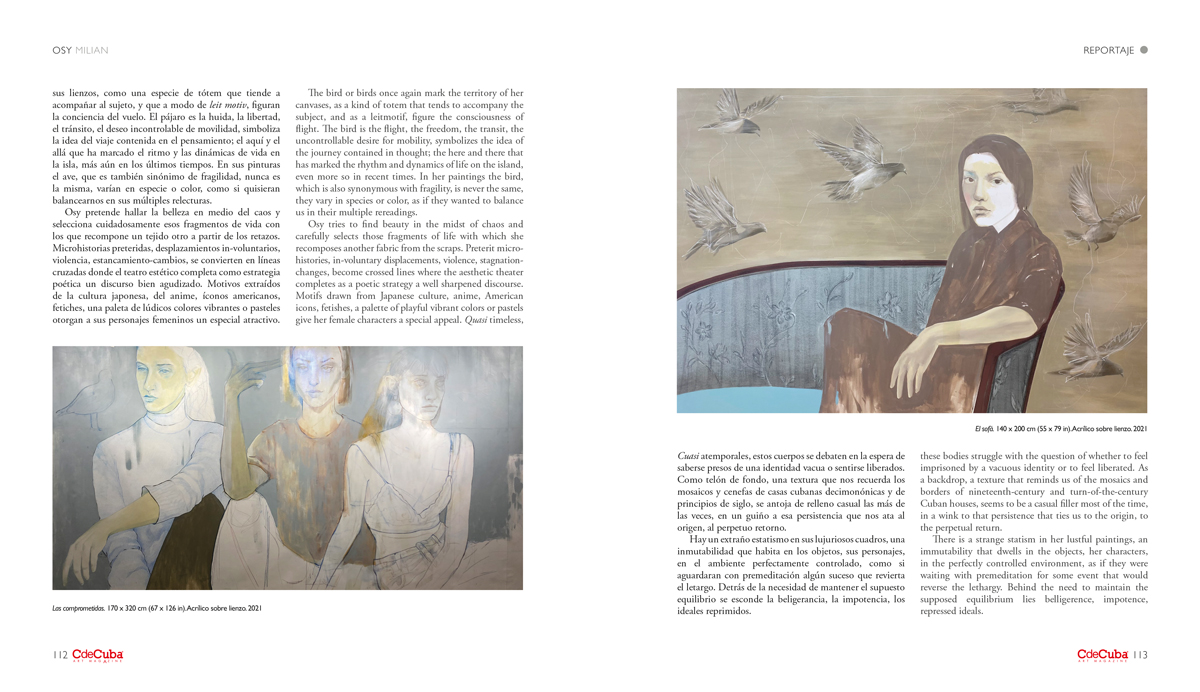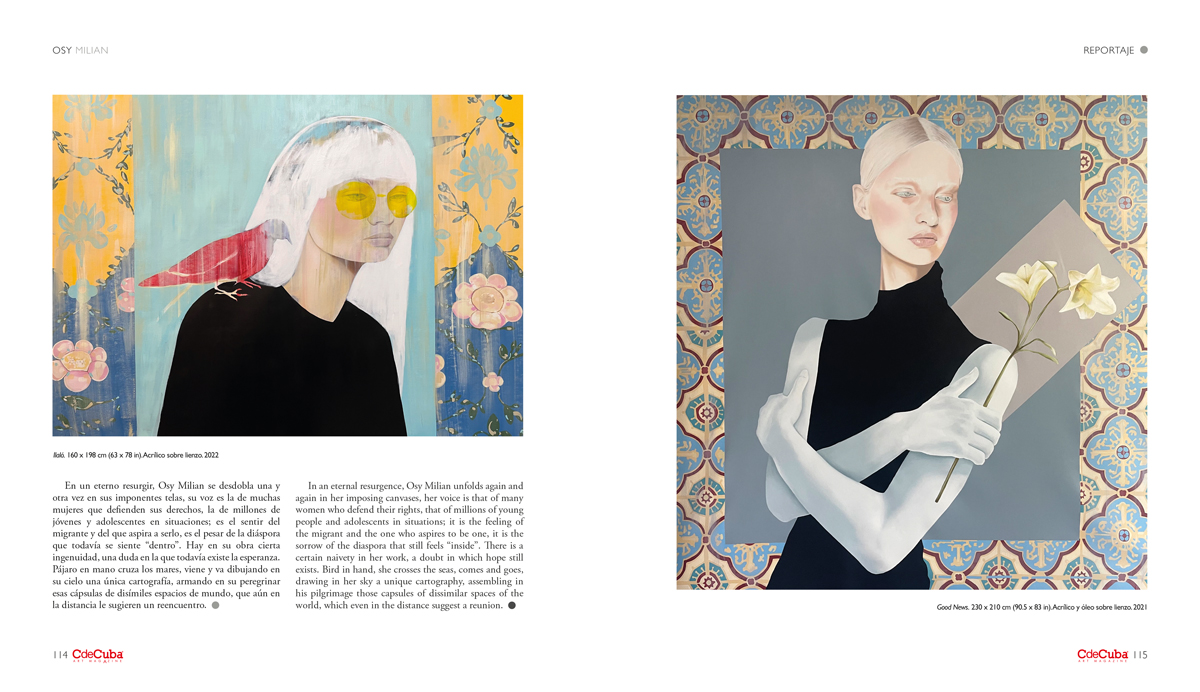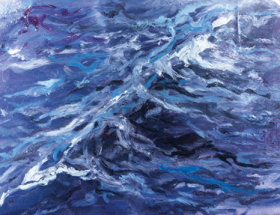Capsules For a Reunion and Birds of Passage…
By Yanet Oviedo Matos
Are we really inside or outside, is perhaps the doubt that has remained inert marking for decades the dialogue and the social psychic development of countless generations of Cubans. A phenomenon that transcends the physical, geographical space and survives in the conscience as a missing link in the chain, of which everyone speculates notions, but no one can speak of a single certainty. Nostalgia, longings, memories, misunderstandings, infinite confluences, destinies, uprootings and attachments, which reach our days renewed, with new nuances and extraordinary strength.
Osy Milian (Havana, 1992) is part of that restless generation that in the 2000s did not know how to remain elusive. –We are no longer the same– the ground is still the same as yesterday, but the feelings have changed. At that time, her carefree images burst into the Cuban art scene, the New Painting that the curator and critic Píter Ortega described in his book Contra la toxina (Against Toxin) (2011) would enlist her within an emerging art that revolutionized the spirit of the moment. The formal synthesis, the precise drawing, the chromatic selection, the graphic and planimetric style of pop influence, would combine indistinctly in a language of their own that has distinguished her work until today.
But the aesthetic incentive is only the vehicle from which she tries to delve into her intimacies, her fears and personal conflicts, in a contingent universe that, with trickery, empathizes to the effect with a generational feeling. Osy is the daughter of the avatars of the new era, of a new wave that positions herself in society, recognizes her conflicts and interests, assumes her sexuality without taboos, questions her identity and belonging.
Cést Moi Cést Nous (2019), Norte (North) (2020), Los Grises (The Greys) (2021) seem like titles for her most recent productions. Each canvas is a life story, the extension of a self-referentiality that connects with a collective experience. Dozens of attractive female portraits embody their respective roles with courage; they are not afraid to go in search of their truth and coldly question the viewer. What are the faces left over from the pandemic –I should write it in capital letters–, how many mixed emotions, how much loss and bewilderment, how many shades of gray, under what mist humanity was translated, Cuba survived. Behind a curtain of ochre brushstrokes, in the penumbra of silence, are the women of El sofá (The Sofa) (2020) and Las comprometidas (The Committed) (2020) Characters who seem immobile before reality, who keep a common secret.
The bird or birds once again mark the territory of her canvases, as a kind of totem that tends to accompany the subject, and as a leitmotif, figure the consciousness of flight. The bird is the flight, the freedom, the transit, the uncontrollable desire for mobility, symbolizes the idea of the journey contained in thought; the here and there that has marked the rhythm and dynamics of life on the island, even more so in recent times. In her paintings the bird, which is also synonymous with fragility, is never the same, they vary in species or color, as if they wanted to balance us in their multiple rereadings.
Osy tries to find beauty in the midst of chaos and carefully selects those fragments of life with which she recomposes another fabric from the scraps. Preterit micro-histories, in-voluntary displacements, violence, stagnation-changes, become crossed lines where the aesthetic theater completes as a poetic strategy a well sharpened discourse. Motifs drawn from Japanese culture, anime, American icons, fetishes, a palette of playful vibrant colors or pastels give her female characters a special appeal. Quasi timeless, these bodies struggle with the question of whether to feel imprisoned by a vacuous identity or to feel liberated. As a backdrop, a texture that reminds us of the mosaics and borders of nineteenth-century and turn-of-the-century Cuban houses, seems to be a casual filler most of the time, in a wink to that persistence that ties us to the origin, to the perpetual return.
There is a strange statism in her lustful paintings, an immutability that dwells in the objects, her characters, in the perfectly controlled environment, as if they were waiting with premeditation for some event that would reverse the lethargy. Behind the need to maintain the supposed equilibrium lies belligerence, impotence, repressed ideals.
In an eternal resurgence, Osy Milian unfolds again and again in her imposing canvases, her voice is that of many women who defend their rights, that of millions of young people and adolescents in situations; it is the feeling of the migrant and the one who aspires to be one, it is the sorrow of the diaspora that still feels “inside”. There is a certain naivety in her work, a doubt in which hope still exists. Bird in hand, she crosses the seas, comes and goes, drawing in her sky a unique cartography, assembling in his pilgrimage those capsules of dissimilar spaces of the world, which even in the distance suggest a reunion.






